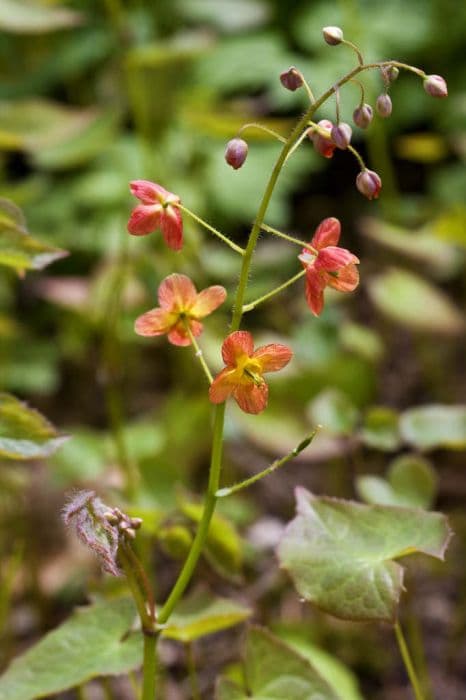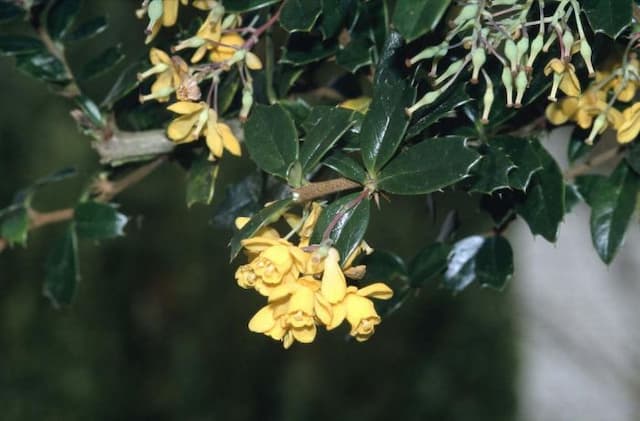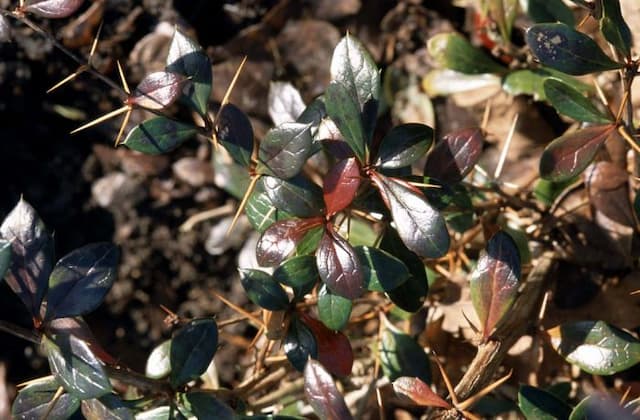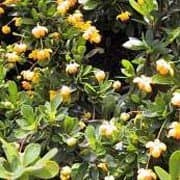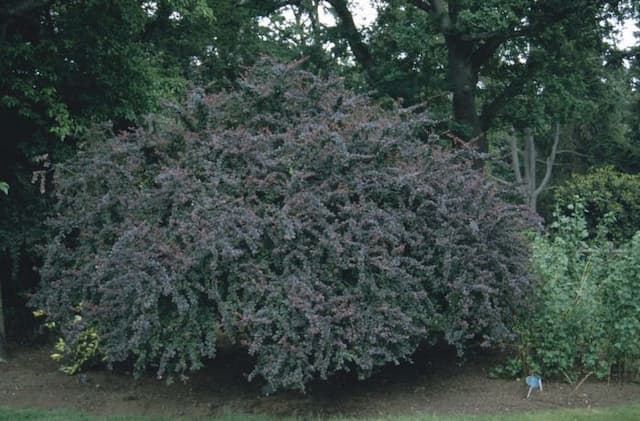Oregon Grape Mahonia × media 'Winter Sun'

ABOUT
Mahonia 'Winter Sun' is an evergreen shrub that boasts a robust and upright growth habit. This particular variety is characterized by its striking architectural form and is a favorite for adding winter interest to gardens. The plant is replete with compound leaves that are composed of multiple leaflets arranged in a pinnate fashion, radiating from a central stem. These leaves exhibit a rich, dark green hue and display a glossy texture, giving the plant a lustrous appearance year-round. Notably, the leaves of 'Winter Sun' have margins that are spiny, much like those of holly, which adds to its unique texture. The edges are serrated, ending in sharp points, which can make the plant prickly to the touch. During the late fall to early winter, 'Winter Sun' transforms as it begins to burst with vibrant yellow flowers. These blossoms gather in dense, upright clusters, known as racemes, which contrast beautifully with the dark foliage. The flowers are elongated and each cluster can be quite showy, with a sweet, subtle scent that may attract pollinators even in the cold months. Following the flowering period, the blossoms give way to berries. The berries initially appear in a greenish hue and then ripen to a deep, bluish-black. These fruit clusters often persist into the winter and can provide a valuable food source for birds when other resources are scarce. The combination of evergreen foliage, bright yellow flowers, and dark berries creates a multi-season display that adds color and interest to garden landscapes.
About this plant
 Names
NamesFamily
Berberidaceae.
Synonyms
Oregon Grape, Grape Holly.
Common names
Mahonia × media 'Winter Sun'.
 Toxicity
ToxicityTo humans
Oregon grape is known to have low toxicity when touched or ingested in small quantities. However, large amounts of the berries may cause vomiting, diarrhea, and lethargy if ingested. The blue-black berries contain berberine, which is considered to have a mildly toxic effect. It's important to avoid consuming parts of the plant in large amounts, especially for individuals with sensitivities to alkaloids.
To pets
Oregon grape is considered to have low toxicity for pets as well. However, similar to humans, if a pet ingests large quantities of the berries, it might experience symptoms such as vomiting, diarrhea, and lethargy. The berries contain the compound berberine, which can have a mildly toxic effect on pets. While occasional small amounts might not cause serious issues, it's prudent to prevent pets from ingesting this plant particularly in large quantities.
 Characteristics
CharacteristicsLife cycle
Perennials
Foliage type
Evergreen
Color of leaves
Green
Flower color
Yellow
Height
6-10 feet (1.8-3 meters)
Spread
4-6 feet (1.2-1.8 meters)
Plant type
Shrub
Hardiness zones
7
Native area
Cultivar
Benefits
 General Benefits
General Benefits- Attractive evergreen foliage - Mahonia × media 'Winter Sun' has lustrous, spiny-toothed leaves that remain green throughout the year, providing continuous interest in the garden.
- Vivid yellow flowers - It produces bright yellow flowers in late fall or winter when few other plants are in bloom, offering a cheerful display during the duller seasons.
- Low maintenance - This plant is relatively easy to care for and requires minimal maintenance once established, making it ideal for both novice and experienced gardeners.
- Drought tolerance - Once established, it is quite tolerant of drought, reducing the need for frequent watering.
- Pest and disease resistance - It is generally resistant to common garden pests and diseases, which reduces the need for chemical treatments.
- Shade tolerance - It can grow in partial shade, making it suitable for understory plantings or north-facing gardens.
- Wildlife attraction - The flowers attract pollinators such as bees, and the subsequent blue-black berries appeal to various birds, supporting biodiversity.
- Architectural interest - With its upright habit and bold, spiky leaves, it adds architectural structure to borders and garden designs.
- Seasonal interest - In addition to winter flowers, it sometimes features fall color as the leaves turn various shades, enhancing the autumn garden.
- Versatility - It can be used in a variety of garden roles, including as a specimen plant, in a mixed border, or as a hedge.
 Medical Properties
Medical PropertiesThis plant is not used for medical purposes.
 Air-purifying Qualities
Air-purifying QualitiesThis plant is not specifically known for air purifying qualities.
 Other Uses
Other Uses- Dye Production: The berries of Mahonia x media 'Winter Sun', commonly known as Oregon Grape, can be used to produce a natural dye for fabric and wool, often resulting in shades of grey, purple, or blue depending on the mordant used.
- Photography: The berries contain a pigment that can be used in the alternative photographic printing process known as anthotype, creating images with the juice of the berries as a photosensitive material.
- Garden Border Edging: With its stiff and spiky foliage, Oregon Grape can serve as a natural, low-maintenance edging plant to define garden paths and borders.
- Fish Pond Protection: The sharp foliage of Oregon Grape can discourage herons and other predators from hunting fish in garden ponds when planted around the edges.
- Erosion Control: The dense, spreading habit of Oregon Grape makes it suitable for hillside planting to prevent soil erosion and stabilize slopes.
- Winter Arrangements: The bright yellow flowers and later the blue-black berries, coupled with the evergreen foliage, make this shrub a popular choice for creating winter floral arrangements and wreaths.
- Feng Shui: Some people utilize Oregon Grape in their garden as part of feng shui practices to add ‘wood’ energy, associated with strength and growth, to their outdoor spaces.
- Nectar Source: It is an excellent early-season nectar source for pollinators, including bees and butterflies, due to its winter blooming period.
- Landscape Design: With its structured appearance and year-round interest, Oregon Grape is used as a specimen shrub in landscape design, especially in woodland gardens and shady areas.
- Thorny Barrier: The thorny nature of Oregon Grape can make it an effective barrier plant to deter unwanted foot traffic and animal activity in certain areas of a garden.
Interesting Facts
 Feng Shui
Feng ShuiThe Mahonia is not used in Feng Shui practice.
 Zodiac Sign Compitability
Zodiac Sign CompitabilityThe Mahonia is not used in astrology practice.
 Plant Symbolism
Plant Symbolism- Resilience: Mahonia × media 'Winter Sun', also known as Oregon Grape, blooms in the coldest season, symbolizing the ability to endure and thrive under harsh conditions.
- Optimism: The bright yellow flowers of the Oregon Grape bring a cheerful splash of color in winter, representing hope and positive expectations for the future.
- Healing: Historically, the plant has been used for its medicinal properties, which makes it a symbol of healing and recovery.
- Vitality: The evergreen nature of Oregon Grape signifies perpetual life and vitality, as it maintains its vibrant green leaves throughout the year.
- Protection: With its holly-like spiky leaves, the Oregon Grape is often considered a symbol of protection, offering a sanctuary for birds in its dense foliage and defending against negativity.
 Water
WaterOregon Grape should be watered thoroughly, allowing the water to penetrate deep into the root zone. During the growing season, provide water once a week, offering about 1 to 1.5 gallons per session for a medium-sized shrub. In hot and dry weather, increase watering frequency to twice a week. Make sure that the soil is moist but not waterlogged, as good drainage is important to avoid root rot. During winter, reduce watering to every two to three weeks, depending on rainfall, as the plant requires less moisture during dormancy.
 Light
LightOregon Grape thrives in partial to full shade conditions. It performs best when planted in a spot that receives filtered sunlight or morning sun followed by afternoon shade. This plant can adapt to varying light conditions but will exhibit the best growth and flowering potential when protected from the intense midday sun.
 Temperature
TemperatureOregon Grape can tolerate a wide range of temperatures, but it prefers a moderate climate. It is hardy and can withstand minimum temperatures down to about 0 degrees Fahrenheit, while the maximum temperature should not exceed 95 degrees Fahrenheit. The ideal temperature range for this plant is between 60 to 70 degrees Fahrenheit during the growing season.
 Pruning
PruningPrune Oregon Grape to maintain its shape and remove any dead or diseased wood. Pruning is best done in late winter or early spring before new growth begins. Periodically thin out overcrowded branches to improve air circulation. Deadheading spent flower clusters may encourage a second blooming and prevent self-seeding if desired.
 Cleaning
CleaningAs needed
 Soil
SoilOregon Grape 'Winter Sun' thrives in well-draining soil with high organic matter content. The ideal soil mix contains equal parts garden soil, peat moss, and sand or perlite, providing acidity and good drainage. The preferred soil pH for this plant is slightly acidic to neutral, around 5.5 to 7.5.
 Repotting
RepottingOregon Grape 'Winter Sun' typically requires repotting every 2 to 3 years to refresh the soil and accommodate root growth. It is best to repot in late winter or early spring before new growth begins.
 Humidity & Misting
Humidity & MistingOregon Grape 'Winter Sun' is adaptable but prefers moderate to high humidity levels, similar to its native woodland environment. A humidity level of around 50% is ideal for this plant.
 Suitable locations
Suitable locationsIndoor
Place Oregon Grape 'Winter Sun' in bright indirect light indoors.
Outdoor
Plant Oregon Grape 'Winter Sun' in partial shade, sheltered from harsh sun.
Hardiness zone
7-9 USDA
 Life cycle
Life cycleMahonia × media 'Winter Sun', commonly known as Oregon grape or Winter Sun, begins its life cycle when the seeds germinate, typically requiring cold stratification to mimic winter conditions before they sprout. Once the seedlings emerge and establish a root system, they grow into juvenile plants, developing pinnate leaves that are evergreen and often have spiny edges. As the plant matures, it enters a vegetative state, focusing on growth and producing dense clusters of dark green foliage. Upon reaching maturity, 'Winter Sun' produces its characteristic bright yellow flowers in late autumn to winter, attracting pollinators and often brightening up the garden during colder months. Following pollination, the flowers develop into dark blue-purple berries, which may be dispersed by birds or other wildlife, thus allowing the plant to propagate. After many years, as the plant ages, it may become less vigorous and may eventually die, completing its life cycle.
 Propogation
PropogationPropogation time
Early Spring
The most popular method of propagation for 'Winter Sun' Mahonia is by semi-ripe cuttings. This is typically done in late summer to early fall, during which time the stems are semi-hardened. You should select a healthy, non-flowering shoot and cut a 4 to 6-inch (10 to 15 cm) length, making sure to include a heel if possible. Strip the lower leaves and dip the cut end in rooting hormone to encourage root growth. Plant the cutting in a mix of peat and perlite or a well-draining potting mix, ensuring that the cut end is well-inserted into the medium. The pot should then be placed in a warm, shaded spot and covered with a plastic bag or placed in a propagator to maintain humidity. Roots typically develop in a few weeks, at which point you can gradually acclimate the cutting to less humid conditions before potting on.


